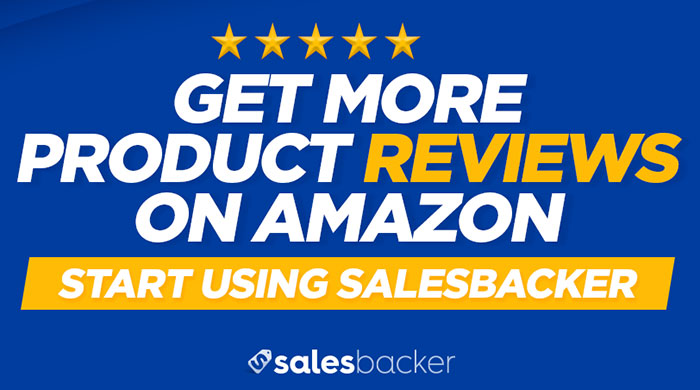 Direct podcast MP3 download link
Direct podcast MP3 download link
Like the show? Get new episodes on iTunes or Stitcher
We're switching things up today, and instead of focusing primarily on selling on Amazon, we're talking about product photography. Steve Kang co-founded a product photography business and in this episode he shares advice on how to make the most of your product photography (even if you take your own product photos).
Listen in if you want advice on how to take better photos for your Amazon product listings.
Want to ask a question?
Get involved and ask a question about selling on Amazon and Chris may answer your question live on a future episode of Sellercast. Also, if you think you'd be a good guest for the Sellercast podcast feel free to tell us more about you and your company here.
Need more product reviews?
If you'd like to get more reviews for your products on Amazon check out Salesbacker.
Show Notes and Links
- Steve's Amazon product photography business: Slanted Frame Photography
Podcast Transcript
Intro: Hello, Chris Guthrie here. And in this episode, we’ll be speaking with Steve who’s a product photographer. And so, this episode is going to be a little bit different. We normally have on ecommerce guests, but I wanted Steve to come on because I’ve known him for a while and he’s talking about, today on this episode, how to improve your product photography. So, whether this is something you do yourself or you decide to hire a third-party to help you out. So, I think you’ll enjoy this episode. Let’s get started.
=====
Chris Guthrie: Hello, everyone. Chris Guthrie here, host at Sellercast. And today, I have Steve on the podcast. Steve, welcome to the show.
Steve: Thank you.
Chris Guthrie: I’ve known you for quite a while, Steve. We always seem to meet up at various events sellers are at. And so, it’s nice to bring you onto the podcast as well. So, thanks for coming. I know that you’re involved on the Amazon business, but primarily, as a photographer. And so you do photography for people that are doing photos for their listings, et cetera. How did you actually get into that?
What I’d really like to focus today on is just how the people that are listening can do their own photos and get the best results. I know that some people that are further along, maybe they’ll want to hire a photographer like yourself or someone else to do that as well, but let’s go with that to start.
Steve: Well, when I started, I started joining ASM 4 and I needed photography for my own products. And as I was searching for a photographer, I actually found a person that I used to work with that was a professional photographer on the side.
So, I asked him for services regarding product photos, and he came back with some excellent work. I started promoting him to Amazon sellers. And then we just decided to partner up because the demand was so high.
So, I knew that if he did good work for me, he would do good work for others as well. So we ended up partnering after that, and here we are today.
Chris Guthrie: And so then, if people are listening, especially if they’re lower budget, maybe they want to do their own photos to start out. I know obviously you’d say maybe “Don’t do that,” but what would you suggest people do if they’re trying to get their photos of their products.
Are people looking at other listings and then using that as a guide or they’re trying to do something entirely new. Maybe you can talk about the process that you use, and they can apply that to their own situation.
Steve: Sure. The process that I use is really understanding the product and the functionality behind the product and the benefit behind it. So, I actually sit down and look at a product and write down all the different functions (which I really call use cases) and the benefits that the product provides.
Usually, those actually are going to be used in your bullet point listings anyway, so you’re not really doing any more work. Once those use cases really are defined and you have a clear idea of what your product can do, then I sit down and say, “Okay, this is the basis for my product photo.”
Now, with that planning comes in mind, “Do you want to do all white background?” which your main image has to be in white background anyway. But the rest of them, do you want all white background or do you want lifestyle, action, or product-in-use photos. So, that’s the process that I go through in defining every one of those steps.
This is the longest part. Usually, I sit down and revert to one or two white fill photos and then the rest will be lifestyle photos.
Chris Guthrie: And so, when deciding how to do lifestyles, it’s really just as basic as, “Okay, this is what the product says. It’s a barbecue grill scraper,” and you’re going to do a photo of the grill scraper in action on a grill basically.
Steve: Yes.
Chris Guthrie: Okay. And then, what about making sure that – well, how actually would they do this? I mean, is it just like a get-a-friend type of thing or what would you suggest if they’re trying to do it themselves?
Steve: First of all, I would say you do have to have a decent camera because your resolution has to be relatively highly. I would say try to keep the image as authentic as possible just as if you were using it. Yes, you do go hire, either a family member or some friends that are wanting to do this with you because a lot of times, it does require two people.
So, in the case of a grill brush, you actually would go out and either use your own barbecue grill. It really doesn’t matter what kind of grill it is, but big enough that people know that there’s a barbecue grill in the picture.
And then, a couple of poses would be of you holding the brush and actually doing a slow scraping motion. If you go too fast, obviously, the image will be blurred. But you really want to show in that case the photo of you actually using it.
And at that point, you can include zoom out of the image where you include the actual person, the model, or you could do it up close where you’re just focused really on the brush touching the grill.
Chris Guthrie: So, I know that you probably have a lot of clients that have had either the photos they’ve done originally or maybe they just did a couple of photos and they didn’t actually fill up every slot. And so, do you see a conversion bump when people do just better photos or they change their photos?
I’m assuming it obviously can affect things, but I’m wondering what you’ve noticed in terms of what’s been the biggest impact on the conversion rate.
Steve: Sure! So that data is very hard to collect because we actually don’t own the photos and we don’t really ask for sales data from our clients. But right now, we are starting to ask for that data for some of the newer customers so that we establish a baseline of conversions.
In my own case, I actually looked back to the data early on when I had my photos done. I replaced a couple of images. I actually did see a bump in my conversion rates. I can’t tell you exactly what the numbers are, but you could see a steady incline in those three months where I did update the photos.
Chris Guthrie: And then, I’m assuming that most people, they get their photos done, especially if they’ve done it themselves, maybe they think about updating them months later. And then that’s about it. People aren’t really changing it that often. Do you work with people that are changing their photos fairly frequently and really trying to nail that down?
I know that any time you’re changing an element on your page, whether it’s your title, your bulletpoints, description, images, et cetera, it’s going to have a potential impact on the conversion. But there are so many other variables as well such as the traffic that happens to be coming to your product at that time. And so you have to see it over a longer period of time.
I’m guessing that that’s just maybe what you’d suggest, try the photos and then have them running for a specific period of time, and then maybe try a different main photo. I’m assuming, of course, the main photo is going to be the biggest influence on that conversion because it’s the one that people see by default.
What would you suggest if people are trying to do some testing with their photos?
Steve: The biggest thing is establishing a baseline in their conversion rate. Most people really miss that point.
So, if you have an existing listing, and you upload your photos, take down what your conversion number is at that point in your central account backend. And then, from there, it’s about adjusting the variables.
I usually tell people to let it run for about 30 days, and then we’ll re-evaluate, collect the data after 30 days.
Chris Guthrie: So, to jump in there actually, you said that you ask them for 30 days. Do they come back to you and then occasionally, you reshoot new photos based on what that data comes up or not yet?
Steve: No, not yet. We’re just at a point where I just want the conversion at 30 days and see if the photos actually made a difference.
Chris Guthrie: Yeah, it makes sense.
Steve: Right! So now, the hard part there is if you change other things in your listings, then we can’t really tell what caused the increase in conversions.
I actually have two examples of this. We do occasionally see people who want to update their photos. A lot of customers have white background photos as their initial launch. And then, after a while, customers come back and say, “Hey, I’d like to do product-in-use photos and really set myself apart from the competition. So, we do see that.
We don’t really see too many people changing their lifestyle photos or action photos. Once they get them, we generally provide a little bit, a couple more images than what the Amazon listing slots has space for, so they have a couple of extra to swap in and out to test out. We don’t really see that too much.
Now, in the other case, we recently had a client that we’re working with (actually, we’re still working with this client) where we changed some colors on the product, and it actually decreased his conversion rate according to him. Let’s say 30 units a day, once we updated that main image to a new color, a new position, he saw that his conversion rate dropped and he wasn’t having as many sales.
He swapped out that new image, put in his old main image and sales got back to normal again.
So, that does happen. It just really depends on how good either the angle, the position, whatever it is, on your main image.
The other part that we see right now is clients actually using a product-in-use photos as their main image. Now, that really is against the Amazon term & conditions for photo requirements, but people do that because then, the product-in-use and lifestyle photo will show up as their main image when you do search results.
Chris Guthrie: Yeah, that’s the thing that I constantly hear from sellers just across the board over the last several years of talking to people that sell on Amazon, that there are varying areas of Amazon that people just knowingly – maybe not knowingly, but they are breaking the rules of what Amazon says. But then since they don’t see anyone getting punished or they see other sellers doing it, then people start to do that.
We saw this with HTML in product listings. People were doing full images for their product descriptions. And then, Amazon eventually makes a change if they don’t like that.
So, it’s an interesting thing. I’m assuming that you just tell your clients to do the white backgrounds since that’s the actual rule on Amazon.
Steve: Yes. We actually try to abide with the terms of service whenever we can. But from our perspective, we just can’t control what the eventual sellers is going to upload to their listing.
From a copyright standpoint, once the photos are delivered to the client, they own the copyright, they could do whatever they want with it because they paid for the service.
Chris Guthrie: Yeah. Yeah, it makes sense. I mean, that’s the same thing. If people ask me something, I’m like, “Well, I wouldn't do that, and I would suggest you don’t,” but they might do it anyway.
Steve: Right, right. So, in that context, the same goes with text, adding text to images. It’s not really against the terms of service, but we just don’t do that for a variety of reasons. And at the end of the day, we kind of categorize that more as a graphic design skill-set, not necessarily a photography skill-set.
So, usually, even if you ask us to put text on the images, we definitely will not do that.
Chris Guthrie: Okay. And even going back to some of the earlier example you gave though, the seller that swapped out a photo and saw a decrease in conversions, I think the biggest takeaway for people who are listening, especially if you’ve been selling on Amazon for some time, if you haven’t changed your images yet, or even tried to change them, that you really should. You might have the opposite effect and have an increase in sales and that might be just the only thing you’ve done.
And so, with any business, especially with selling on Amazon, you’ve got to be testing, and running tests. And of course, don’t too many too many variables at once. Well, actually, you only do one variable like, say, changing your main image. Too many things at once, you don’t know what caused the influence in conversions.
Steve: Yup! And I would agree with that. It’s a pretty difficult task to decide which image it actually was. It really is a trial-and-error. You really can’t do – I guess look at it from a scientific perspective. You change too many variables. You definitely are going to not know. One or two, you’ll be able to narrow it down if that caused an effect or not.
Chris Guthrie: Yeah. And I know we just jumped right into the meat of it talking about just the various aspects of doing images, changing images and what may influence them. Let’s take a step back.
So, someone is launching a new product, what should they do? Should they focus on writing their sales copy or should they take photos of their products first, and then match the photos to their sales copy? What do you suggest to people?
Steve: I would say work on your sales copy first because that’s where the real idea comes from at the end of the day.
You get all your keywords research. Really think about the benefits and the features you really want to display or you really want to put in your listing that would make people want to buy.
At the end of the day, one of the mentors I heard, “Every product solves a specific problem.” Well, that’s the key takeaway that I use in a lot of these product photos.
So, if you have a good listing, then that’ll make your job easier in taking photos for your product.
Chris Guthrie: That makes sense. Yeah, when you mention the features, advantages and benefits, I think back to my college years. I had a professor (because I had a degree in marketing) that talks about – there’s this book that we had to read. And before that time, I hadn’t been familiar with the copywriting process and how you should use features, advantages and benefits.
I can find that book title again because the book was great. It helped change my thinking. I just forgot the title. But I can find that and I’ll mention that in the show notes here for people that wanted to check that out as well. If you’ve never sold anything before or you haven’t done your listing copy before and you’re looking for ideas on how to frame it, that can help.
We also did another episode earlier (and I’ll link to that as well) about copywriting. So, you can check that out too if you’re getting started.
Let’s talk about some of these lifestyle and in-action photos. Obviously, if you’re doing it, you need to have a second person. Have you found a difference in different types of models or if people are involved or whether or not you just do a photo of the product itself? I’m assuming it kind of comes down to what product you’re selling.
Steve: Right! I think what makes the most sense is using actual models in your photos. At the end of the day, you and I are both consumers, and so we’re trying to figure out whether this product will solve our problem or if it’s the right fit for our particular needs. And since we can’t touch them or feel them or anything like that, it’s usually best to depict as much of the real life as possible in the image.
So, what I would recommend you do is really get a model to demo your product. And that person hold still in the action of using the product. And then, you can take a picture of that.
Now, let’s get down to models. Everyone, whenever I got to hunting – or searching, let’s just say searching for models…
Chris Guthrie: [Laughs]
Steve: Yeah, searching for models, they could be babies, men, women, anybody. A lot of times people think you have to be like the Hollywood runway models in order to do product photographies. The answer is no. That’s not what we do.
Now, having said that, it does matter in the model you select because you do have to match that person up with the particular product. At the end of the day, the photo has to be believable.
You’re not going to take a baby product and have two adults model it. That just doesn’t make sense. So, if it’s not believable, people just laugh at that.
And so, you really want to select who that person you think would be the target demographic that would use that particular product.
Now, cellphone cases, we see a couple of cellphone cases come our way. That could be a wide range. And that’s probably the most versatile product. It could be senior citizens. It could be children, high school kids, teenagers. It could be adults, I guess middle-age adults. So there, you have some flexibility.
But baby products is a good example. You’re really not going to have a 5-year old kid or an adult model baby products. So, I would say use your best judgment on that.
Chris Guthrie: How are you finding these models? Are you using something like – I was going to say Craigslist, but that could end up with a weird scenario potentially.
Steve: Right, right.
Chris Guthrie: When you need a model for this product, are there websites or is it just find your Facebook profile and see who most matches my target demographic and invite them out?
Steve: Sure, sure. I do it really simple. I actually either look through some friends or I usually have friends of friends and look at their pictures. Or I have people in mind that I know that I’ve either worked with or friends with or somebody I’ve ran into and have a connection with at one point in time. That’s generally how I find the models.
In fact, this last time, my partner and I went to a vendor fair of outdoor wildlife equipment. And there was a girl there that was selling her products as a vendor. We just thought, “Hey, you know what? She might be a good fit for some of our products when we get there.” So, we just asked her, “Hey, are you interested in being a model for – we have an Amazon business, a photography business...”
It’s kind of weird at first. But at the same time, it’s kind of… It’s a little nerve-wrecking for people, but you just have to frame it right for them.
I usually don’t say, “Hey, you want to be a model? Come work with us.” That usually doesn’t work. You have to tell them, “Hey, this is for an Amazon listing. It’s for a product. It’s going to be shown worldwide. And we may also use you for a Facebook ad. Are you interested?”
Believe it or not, some people say no because they just don’t want bad exposure to the public.
Chris Guthrie: Yeah, makes sense.
Steve: Yeah.
Chris Guthrie: One question actually too then. I know because a friend of mine has a photography business. He’s based in the Seattle area as well. He has model release forms. Occasionally, he does that.
Would you suggest people do that as well, getting a model release form in terms of using their likeness, et cetera? I guess if it’s a friend, it’s kind of like – well, you never know what may happen.
Steve: Right! Right, right. If it’s a one-time deal, I wouldn't worry about it too much. By the way, I’m not a lawyer.
Chris Guthrie: Yeah, it’s kind of a legal question.
Steve: Right! But what I do, if it’s a one-time deal, I can probably get away with that. But if it’s like continuous, you’re doing it all the time with people you don’t know, or even if you feel uncomfortable with people you don’t know, definitely have a model release form as I would say. You never know what could happen in the future.
I mean, your imagination can run wild on the legal ramifications of that, but you just want to protect yourself at the end of the day because you’re a business at that point. And if anybody sues you for this thing, you never know what’s going to happen. So, I would definitely say yes.
Chris Guthrie: Yeah, yeah. All the different typical disclaimers, obviously, do your own due diligence.
So, let’s talk about the actual photo process, maybe some of the equipment. If someone is doing this themselves, most people, they’re using their iPhone or their Android phone, et cetera, and they’re taking photos, or maybe hitting up their friend for a dSLR, a Canon or something.
Steve: I mean, the new cell phones, the new iPhones and the Galaxy phones have some pretty good cameras on them, so you could probably get away with a cellphone camera. But in most cases, in our case, actually, we use a Canon 5D Mark III. That’s a high-end camera. But I would say that any dSLR will work as long as you have the correct lighting and the proper environment to shoot the picture in.
I believe early on when we were doing just the white background photos, we had a little light tent set up. All we used was, I think, a Minolta. My partner, I think he had a Minolta point-and-shoot really. You would never know the difference. It wasn’t this high-powered camera. It was just a midline point-and-shoot. And we had some happy customers on that.
Chris Guthrie: Let’s actually touch on that briefly, the lighting aspects. So, I know if you’re doing a lightbox (and that’s a separate piece of equipment that you need to set up and all that), very briefly, is that something where – if someone is doing it themselves, I’m assuming that maybe outside is best because they can just use, obviously, outside light. Is there a best time of day or a certain type of weather that’s better for taking photos outside?
Steve: Sure! For us, in general, day time is the best I would say, mid-morning to I would say late afternoon. If it’s too sunny out, you might just get overexposure. I wouldn’t even say indirect sunlight doesn’t always work because you’re really trying to preserve that color in the image compared to the actual product.
If you do it in the dark, the image can be really grainy, so that doesn’t work.
Chris Guthrie: Unless the product, of course, is relevant to the dark.
Steve: Right, right. We recently had that. A recent product required some weather. That was really tough to shoot because the weather changes constantly. So, I think you just have to compensate for that.
But in most cases, we really like to shoot in the day time just because we have a little bit more control and flexibility. If the shot doesn’t look right, we’re not in a mad rush because the sunlight is going down.
We’ve had those kind of cases where the sun is going down, and it’s like, “We got to hurry!”
Chris Guthrie: What about other uses for the photos? I mean, are people doing different photos for different variations or they’re just using Photoshop and doing color replacement type of stuff for doing different photos of different products type of thing?
Steve: So, up until now, a lot of our customers have been one-time – we do have some returning customers, but that’s based on new products. I mean, these are images that you could pretty much use anywhere. So it’s really up to you to decide if you want to use it for a website or a landing page. You could do all that stuff. If you want to use it for a Facebook ad, you could do all that stuff, and Instagram as well.
Chris Guthrie: Yeah.
Steve: But for variations, it’s kind of tough because at the end of the day, it boils down to cost. People can use them for variations. I mean, it may not be the same color. But if you want to do that, you can do that.
Changing colors on an image of the product just digitally, you could do that with a lot of these big companies like Fiverr or Upwork and all those kind of places. You probably send them over and they can do that stuff for you.
Chris Guthrie: Yeah, definitely. We’re getting near the end here, but I want to focus primarily on just some of the mistakes that you see when you look at listings.
So, I’m assuming that your clients come to you, you look at their existing photos. And obviously, they’re coming to you because either they already have existing photos and they’re not seeing the results that they want with their sales, and so you’re trying to reverse that. What are the most common mistakes that you see people are doing with their own photos?
Steve: I really see that people just have white background photos. They just don’t know where to start for lifestyle or action photos. That’s probably the most common that I see. The image part of it is relatively new that I think some people just don’t even think that, “Hey, maybe product-in-use photos would be good.”
The other part I see (that we fixed some) is that the angle in which the image was shot did not display the product properly. You don’t think about that, but there are a couple of photos that I’ve seen where the question I ask is, “What are we selling here? What does this look like?”
If you can’t answer that question based on the image or if somebody else asked that question based on the picture, then you need to re-take that shot because nobody should be able to ask that question especially on a listing.
You should be able to see it right away. It will be like, “Oh, okay.We’re selling a bracelet… oh, we’re selling mattress pads.” I mean, some parts are hard, right? Mattress pads are one of those.
We’ve seen a couple of mattress pads, sheets, bedsheets, those are really hard. But at the end of the day, people should know that, “Hey, you’re selling bedsheets… you’re selling a mattress pad.”
Chris Guthrie: Yeah, that makes sense. I think that that’s a good question to ask. “What am I selling? Is it instantly recognizable what problem does this product solves?” for example.
Steve: Right! Yup.
Chris Guthrie: Yeah, that’s great.
Also, is there anything else that you’d suggest to people that are looking at taking their own photos just to try to get the best results possible?
Steve: It’s usually lighting. I think lighting and the features of the products, those are the two things. Lighting is really hard, so it might take you a couple of times, some trial-and-error to get that done or to really perfect that.
But I would say what I spend most of my time when helping clients is the features, really getting the features out of them. And so, I would say if you can identify your features of what you want to show, that’s probably about, I would say, 80% there.
Chris Guthrie: Alright! Thanks, Steve, for coming on to talk about product photography. I think especially if people are newer sellers, then some of the tips on how to improve the photos they do for their listings is great. And so, for those that have already been doing photos for a while, I hope you’ve picked up a few tips as well.
And likewise, if you have other questions, I’ll put the links to the show notes here in a bit, feel free to post them and see if you can chime in if you have any suggestions on how to improve your photos. You can jump in there as well.
So, thanks again, Steve, for coming on and talking to us about product photography.
Steve: Hey, thanks for having me.
Chris Guthrie: Alright! That was the episode with Steve. Hopefully, you enjoyed that on product photography and picked up a few tips that you can apply to your own business.
I think the biggest takeaway is if you’re already selling on Amazon and you have been for quite some time and you haven’t changed your images for your product, that’s one of the first things you can consider testing if you haven’t done that recently. So, that’s a great takeaway.
And also, if you want to check out Steve’s website, you can go to SlantedFramePhoto.com. And the shownotes link is Sellercast.com/31. Thank you so much for tuning in. I’ll see you in the next episode!





